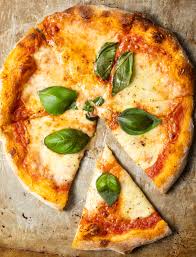Neapolitan Pizza, or Pizza Napoletana, is a classic Italian dish that has captured the hearts and taste buds of pizza lovers worldwide. This pizza is known for its simplicity, authenticity, and traditional methods of preparation. It’s a dish that has remained virtually unchanged for centuries, making it a true staple of Neapolitan cuisine. In this blog, we’ll delve into the origins of Neapolitan pizza, its ingredients, how to make it, its health benefits, and the best ways to enjoy it.
About Neapolitan Pizza
The history of this pizza dates back to the 18th century, where it was first created in Naples, Italy. According to legend, the pizza was first made for Queen Margherita of Savoy by a local pizzaiolo named Raffaele Esposito. He made three pizzas, one with tomatoes, basil, and mozzarella cheese, which resembled the colors of the Italian flag. The queen loved the pizza, and it became known as Pizza Margherita, cementing its place in pizza history.
Today, it is protected by the European Union and can only be made using specific ingredients and techniques. The crust must be made from wheat flour, natural yeast, water, and salt, and cooked in a wood-fired oven at high temperatures to create a crispy exterior and a soft, chewy interior. The toppings are simple and include San Marzano tomatoes, fresh mozzarella cheese, basil, and olive oil.
Neapolitan Pizza
Making this pizza requires patience, attention to detail, and a lot of practice. The dough must be prepared in advance and left to rise for at least 8-12 hours. Once the dough is ready, it’s time to shape the pizza and add the toppings. The pizza is then cooked in a wood-fired oven for about 60-90 seconds until the crust is blistered and charred.
Despite its simple ingredients, it packs a punch in terms of nutrition. The tomatoes used in the sauce are a rich source of vitamins A and C, while the mozzarella cheese provides calcium, protein, and vitamin B12. The pizza’s crust, made from high-quality wheat flour, is also a good source of fiber and essential minerals.
When it comes to pairing, it’s best enjoyed with a cold beer or a glass of red wine. The pizza’s flavors and textures pair perfectly with the bitter, hoppy flavors of a cold beer or the tannins of red wine.
How to Prepare Neapolitan Pizza
Additionally, the Neapolitan Pizza Association (Associazione Verace Pizza Napoletana) has strict guidelines on how this pizza should be prepared. According to their guidelines, its dough should be made with only four ingredients: water, flour, salt, and yeast. The dough should be kneaded by hand or with a low-speed mixer and should be left to rise for a specific amount of time.
The toppings for this pizza are also limited, with the classic Margherita being the most popular. It features tomato sauce, fresh mozzarella cheese, basil, and olive oil. Other popular toppings include prosciutto, mushrooms, and artichokes.
More Info
While Neapolitan pizza may seem simple, it takes skill and technique to get it right. Here are the steps:
- Make the Dough: The dough is made with flour, water, salt, and yeast. The dough is left to rise for several hours, then kneaded and shaped into individual pizza rounds.
- Add the Sauce: its sauce is made from San Marzano tomatoes, which are grown in the volcanic soil near Mount Vesuvius. The tomatoes are crushed and mixed with salt and sometimes a bit of olive oil. The sauce is added to the center of the pizza round and spread out to the edges.
- Add the Cheese: This pizza is traditionally made with fresh mozzarella cheese, which is sliced and placed on top of the sauce. Some pizzaioli (pizza makers) also add a bit of grated Parmesan cheese for extra flavor.
- Bake the Pizza: This is cooked in a wood-fired oven at a temperature of around 900 degrees Fahrenheit. The pizza is placed on a peel (a long-handled tool used for transferring the pizza to and from the oven) and quickly slid into the oven. The pizza only takes about 60-90 seconds to cook, and should have a charred, bubbly crust when it’s done.
- Add Toppings (Optional): While traditional Neapolitan pizza is just sauce, cheese, and maybe a bit of basil, some pizzerias offer toppings such as prosciutto, mushrooms, or olives. However, adding too many toppings can make the pizza too heavy and take away from the simplicity and balance of flavors that are characteristic of this pizza.
Health Benefits and Nutritional Value
Neapolitan pizza can also provide some health benefits due to its nutrient-rich ingredients. The use of fresh, high-quality ingredients such as San Marzano tomatoes and fresh buffalo mozzarella can provide a range of vitamins and minerals such as calcium, vitamin C, and vitamin A. The use of olive oil in the preparation of the pizza crust also adds healthy fats to the dish.
However, it is important to note that Neapolitan pizza should still be consumed in moderation as it is still a high-calorie food. One slice of Neapolitan pizza can contain anywhere from 200-400 calories depending on the toppings used.
What to Eat Neapolitan Pizza With
Neapolitan pizza is often enjoyed on its own, but it can also be paired with a variety of accompaniments. Some popular options include a fresh green salad, roasted vegetables, or a side of olives or pickles. A cold beer or a glass of red wine can also complement the flavors of the pizza. When it comes to eating Neapolitan Pizza, it’s traditionally served as a whole pizza, meant to be shared among a group. It’s also common to eat Neapolitan Pizza with a knife and fork, rather than using your hands.

Neapolitan Pizza Recipe
Making Neapolitan pizza at home can be a fun and rewarding experience. Here is a basic recipe for Neapolitan pizza:
Ingredients:
- 3 1/2 cups flour (ideally Caputo tipo 00 flour)
- 1 1/3 cups water
- 1 1/2 tsp salt
- 1/4 tsp active dry yeast
- San Marzano tomato sauce
- Fresh buffalo mozzarella cheese
- Fresh basil leaves
- Olive oil
Instructions:
- In a large mixing bowl, combine the flour, salt, and yeast.
- Gradually add in the water and mix until a dough forms.
- Knead the dough for about 10 minutes until it becomes smooth and elastic.
- Cover the dough with a damp cloth and let it rest for about 2 hours.
- Preheat the oven to its highest temperature (usually around 500-550 degrees Fahrenheit).
- On a floured surface, stretch out the dough to form a circular shape.
- Spread the San Marzano tomato sauce over the dough, leaving about 1 inch around the edge.
- Add slices of fresh buffalo mozzarella cheese on top of the sauce.
- Drizzle olive oil over the cheese.
- Place the pizza on a pizza stone or baking sheet and bake in the preheated oven for about 8-10 minutes, or until the crust is crispy and the cheese is melted.
- Top with fresh basil leaves and serve hot.
Frequently Asked Questions
Q: What makes Neapolitan pizza different from other types of pizza?
A: Neapolitan pizza is unique in its use of high-quality, simple ingredients and its strict adherence to specific preparation and cooking methods. It is characterized by its thin, crispy crust and fresh, flavorful toppings.
Q: What is the origin of Neapolitan pizza?
A: Neapolitan pizza originated in Naples, Italy in the 18th century. It was originally made with simple ingredients that were readily available to the working class, such as San Marzano tomatoes and buffalo mozzarella cheese.
Q: What is the nutritional value of Neapolitan pizza?
A: Neapolitan pizza can provide a range of vitamins and minerals due to its use of fresh, high-quality ingredients such as tomatoes and mozzarella cheese. However, it should still be consumed in moderation as it is a high-calorie food.
Q: What are some popular toppings for Neapolitan pizza?
A: Popular toppings for Neapolitan pizza include fresh basil, prosciutto, arugula, and various types of cheese such as ricotta or gorgonzola.
Conclusion
Neapolitan pizza is a true icon of Italian cuisine and is loved by pizza enthusiasts worldwide. Its history and traditions have been preserved for centuries, and the simple, authentic flavors continue to delight pizza lovers. Making Neapolitan pizza may require some practice, but the results are well worth it. With a few high-quality ingredients and a little bit of patience, you can create an authentic Neapolitan pizza in your own home.
See Also: https://infoblog4all.com/pecking-duck/

